- Home
- News
- General News
- Exploring the last...
Exploring the last white spot on Earth
09-11-2011
Grenoble, 10 November 2011 – Scientists will soon be exploring matter at temperatures and pressures so extreme that the conditions can only be produced for microseconds using powerful pulsed lasers. Matter in such states is present in the Earth’s liquid iron core, 2500 kilometres beneath the surface, and also in elusive “warm dense matter” inside large planets like Jupiter. A new X-ray beamline ID24 at the European Synchrotron Radiation Facility (ESRF) in Grenoble, France, allows a new level of exploration of the last white spot on our globe: the centre of the Earth.
Share
We know surprisingly little about the interior of the Earth. The pressure at the centre can be calculated accurately from the propagation of earthquake waves; it is about three and a half million times atmospheric pressure. The temperature at the centre of the Earth, however, is unknown, but is thought to be roughly as hot as the surface of the sun.
ID24, which was inaugurated today, opens new fields of science, being able to observe many rapid processes, like in a time-lapse film sequence, whether laser-heating of iron to 10,000 degrees, charge reactions in new batteries or catalysts cleaning pollutants. It is the first of eight new beamlines to be built within the ESRF Upgrade Programme, a 180 million Euro investment over eight years, to maintain the world-leading role of the ESRF. ID24 extends the existing capabilities at the ESRF in X-ray absorption spectroscopy to sample volumes twenty times smaller and time resolutions one thousand times better than in the past.
“Scientists can use several other synchrotrons notably in Japan and the U.S for fast X-ray absorption spectroscopy, but it is the microsecond time resolution for single shot acquisition coupled to the micrometre sized spot that makes ID24 unique worldwide," says Sakura Pascarelli, scientist in charge of ID24. "The rebuilt ID24 sets the ESRF apart, and even before the first users have arrived, I am being asked to share our technology.”
The Earth’s interior is literally inaccessible and today it is easier to reach Mars than to visit even the base of the Earth’s thin crust. Scientists can however reproduce the extreme pressure and temperature of a planet’s interior in the laboratory, using diamond anvil cells to squeeze a material and once under pressure, heat it with short, intense laser pulses. However, these samples are not bigger than the size of a speck of dust and remain stable under high temperatures only for very short time, measured in microseconds.
Thanks to new technologies employed at ID24, scientists can now study what happens at extreme conditions, for example when materials undergo a fast chemical reaction or at what temperature a mineral will melt in the interior of a planet. Germanium micro strip detectors enable measurements to be made sequentially and very rapidly (a million per second) in order not to miss any detail. A stable, microscopic X-ray beam means that measurements can also be made in two dimensions by scanning across a sample to obtain a map instead of only at a single point. A powerful infrared spectrometer complements the X-ray detectors for the study of chemical reactions under industrial processing conditions.
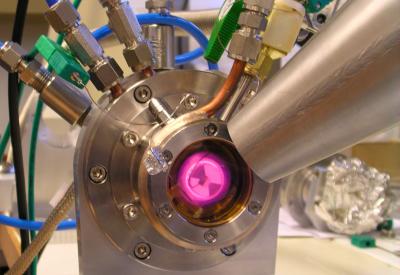 |
A catalytic cell with a sample heated under in situ conditions for analysis with a beam of X-rays. Image credit: ESRF/B. Gorges. |
Today, geologists want to know whether a chemical reaction exists between the Earth’s mostly liquid core and the rocky mantle surrounding it. They would like to know the melting temperature of materials other than iron that might be present in the Earth’s core in order to make better models for how the core—which produces the Earth’s magnetic field—works and to understand why the magnetic field changes over time and why periodically in Earth’s history it has disappeared and reversed.
We know even less about warm dense matter believed to exist in the core of larger planets, for example Jupiter, which should be even hotter and denser. It can be produced in the laboratory using extremely powerful laser shock pulses compressing and heating a sample. The dream of revealing the secrets of the electronic and local structure in this state of matter with X-rays is now becoming reality, as ID24 allows sample volumes 10000 times smaller than those at the high power laser facilities to be studied, making these experiments possible at the synchrotron using table top lasers.
The ID24 beamline works like an active probe rather than a passive detector, firing an intense beam of X-rays at a sample. The technique used is called X-ray absorption spectroscopy and it involves the element specific absorption of X-rays by the atoms in a material. From this data not only the abundance of an element can be deducted but also its chemical states and which other atoms, or elements, are in their immediate neighbourhood, and even how far apart they are. In short, a complete picture is obtained of the sample at the atomic scale.
ID24 has just successfully completed first tests with X-ray beams. Testing will continue over the coming weeks, and the beamline will be open for users from around the world as of May 2012. The date for the inauguration on 10 November 2011 was chosen to coincide with the autumn meeting of the ESRF’s Science Advisory Committee of external experts who played a key role in selecting the science case for ID24 and the other Upgrade Beamlines.
“ID24 opens unchartered territories of scientific exploration, as will the seven other beamlines of the ESRF Upgrade Programme. The economic crisis has hit our budgets hard, and it is not obvious to deliver new opportunities for research and industrial innovation under these circumstances”, says Harald Reichert, ESRF Director of Research. “I wish to congratulate the project team for extraordinary achievements, and I look forward to seeing some extraordinary new science.”
The inauguration ceremony
Ribbons were cut to mark the opening of two new beamline branches.
1. High-pressure/extreme conditions branch. From left to right: Francesco Sette, ESRF Director General, Sakura Pascarelli, Scientist in charge of ID24, Harald Reichert, ESRF Research Director.
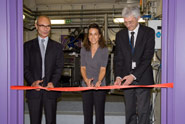 |
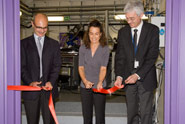 |
2. Chemistry branch. From left to right: Michel van der Rest, vice-chairman ESRF Council, Geneviève Fioraso, Députée de l'Isère et Adjointe au Maire chargée de l'Economie, l'Emploi, l'Université, la Recherche, Rafael Abela, Chairman ESRF SAC.
 |
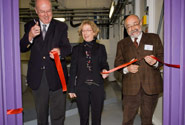 |
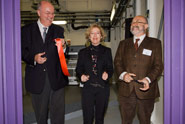 |
Photos credit: ESRF/C. Argoud
Top image: The layers of the Earth: the thin upper crust, the viscous upper and lower mantle, the liquid core and the solid inner core.




